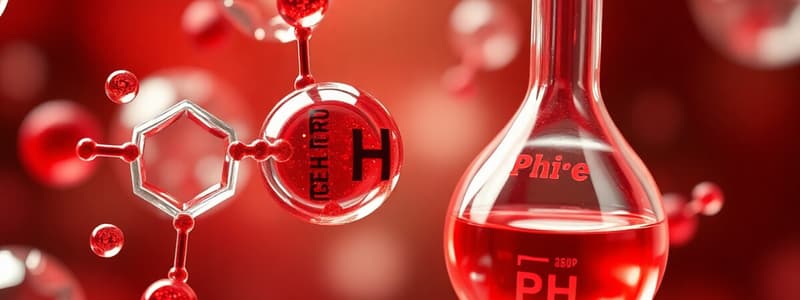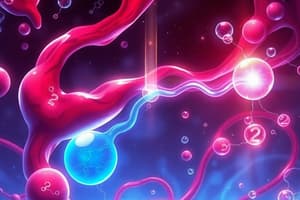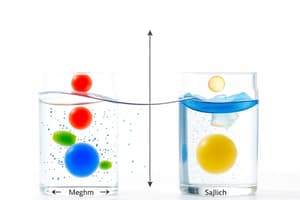Podcast
Questions and Answers
What is the normal pH level of blood?
What is the normal pH level of blood?
- 8.0
- 6.5
- 7.0
- 7.4 (correct)
Which substance acts as a good buffer molecule in the extracellular fluid?
Which substance acts as a good buffer molecule in the extracellular fluid?
- Potassium
- Bicarbonate (correct)
- Sodium ion
- Phosphate
What is the primary role of bicarbonate in the body?
What is the primary role of bicarbonate in the body?
- To transport oxygen
- To serve as a buffer (correct)
- To increase acidity
- To act as an enzyme
What type of molecule has amphoteric nature, meaning it can act as both an acid and a base?
What type of molecule has amphoteric nature, meaning it can act as both an acid and a base?
In which compartment of the body is phosphate predominantly found?
In which compartment of the body is phosphate predominantly found?
Which compound is primarily responsible for maintaining the pH balance in the extracellular fluid?
Which compound is primarily responsible for maintaining the pH balance in the extracellular fluid?
In what situation would the buffering capacity of bicarbonate be compromised?
In what situation would the buffering capacity of bicarbonate be compromised?
Which of the following statements regarding phosphate in the body is accurate?
Which of the following statements regarding phosphate in the body is accurate?
What effect does a decrease in extracellular bicarbonate concentration typically have?
What effect does a decrease in extracellular bicarbonate concentration typically have?
Which physiological condition is associated with 'fruity breath' due to high ketone levels?
Which physiological condition is associated with 'fruity breath' due to high ketone levels?
Flashcards
Blood pH
Blood pH
The measure of acidity or alkalinity in blood, typically maintained at 7.4.
Buffering in blood
Buffering in blood
Blood uses phosphate and bicarbonate as important buffer systems to regulate pH.
Kidney role in blood pH
Kidney role in blood pH
The kidneys play a crucial role in regulating blood pH by controlling the concentration of bicarbonate.
Acid-base imbalance
Acid-base imbalance
Signup and view all the flashcards
Diabetic ketoacidosis
Diabetic ketoacidosis
Signup and view all the flashcards
What is the normal blood pH?
What is the normal blood pH?
Signup and view all the flashcards
What are the main buffer systems in blood?
What are the main buffer systems in blood?
Signup and view all the flashcards
How does the kidney contribute to blood pH?
How does the kidney contribute to blood pH?
Signup and view all the flashcards
What is acidosis?
What is acidosis?
Signup and view all the flashcards
What is diabetic ketoacidosis?
What is diabetic ketoacidosis?
Signup and view all the flashcards
Study Notes
Blood pH
- Normal blood pH range is 7.35-7.45
- Blood pH is tightly regulated to maintain homeostasis.
- Many cellular functions are sensitive to pH changes.
- Changes outside the normal range can have serious health consequences.
- Acidemia (pH below 7.35) leads to acidosis.
- Alkalemia (pH above 7.45) leads to alkalosis.
Objectives
- Define the normal ranges of blood pH.
- Describe the chemical equations for bicarbonate, phosphate, and protein buffer systems.
- Discuss the body's defenses against changes in hydrogen ion concentration.
- Identify common causes and types of acidosis and alkalosis.
- Explain the effects of pH imbalances.
Acids and Bases
- Acids donate hydrogen ions (H+).
- Strong acids release many H+ ions.
- Weak acids release few H+ ions.
- Bases accept hydrogen ions (H+).
- Strong bases release many hydroxide ions (OH-).
- Weak bases release few hydroxide ions (OH-).
Buffer Systems
- Chemical buffers react quickly to prevent large pH changes.
- Bicarbonate buffer system is important in blood.
- Phosphate buffer system is crucial for intracellular and urinary pH.
- Protein buffer system is vital, since proteins contain amino and carboxyl groups that can act as buffers.
Respiratory System Buffering
- The respiratory system regulates CO2 levels.
- Increased CO2 leads to lower pH (acidosis).
- Decreased CO2 leads to higher pH (alkalosis).
- The rate and depth of breathing are altered to control CO2.
- This is a rapid but short-term response.
Kidney System Buffering
- The kidney is the most potent buffer system.
- It actively excretes H+ and reabsorbs bicarbonate.
- This is a slower, longer-lasting response to regulate pH.
- The kidneys maintain pH balance by excreting excess H and producing bicarbonate from carbon dioxide.
Acid-Base Disorders
- Acid-base disorders are imbalances in pH due to changes in arterial PCO2, serum HCO3- and pH.
- Respiratory acidosis is caused by reduced CO2 elimination.
- Respiratory alkalosis is caused by excessive CO2 elimination.
- Metabolic acidosis is due to increased acid production or bicarbonate loss.
- Metabolic alkalosis is caused by bicarbonate gain or acid loss.
Effects of Acidosis and Alkalosis
- Acidosis leads to confusion, disorientation, and coma.
- Alkalosis causes muscle spasms, convulsions, or respiratory paralysis.
- Both acidosis and alkalosis have significant effects on body systems and can be life-threatening if severe.
Studying That Suits You
Use AI to generate personalized quizzes and flashcards to suit your learning preferences.




